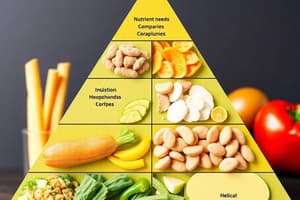Podcast
Questions and Answers
What is the optimal number of servings from each food group to be eaten daily?
What is the optimal number of servings from each food group to be eaten daily?
- It depends on the food group (correct)
- 6 servings
- 5 servings
- 7 servings
When was the first food pyramid published?
When was the first food pyramid published?
- 1974 (correct)
- 2005
- 1992
- 2011
Which organization presents guidelines in a food pyramid as a table?
Which organization presents guidelines in a food pyramid as a table?
- UNICEF
- WHO and FAO (correct)
- USDA
- World Food Program
What was the name of the USDA food pyramid updated in 2005?
What was the name of the USDA food pyramid updated in 2005?
What is the main nutrient provided by grains?
What is the main nutrient provided by grains?
What is the main nutrient provided by dairy products?
What is the main nutrient provided by dairy products?
What is the main nutrient provided by meat?
What is the main nutrient provided by meat?
What is the tip of the food pyramid composed of?
What is the tip of the food pyramid composed of?
What is the main nutrient provided by fruits?
What is the main nutrient provided by fruits?
Flashcards
Optimal Daily Servings
Optimal Daily Servings
Differs by food group based on individual needs and dietary guidelines.
First Food Pyramid?
First Food Pyramid?
The first food pyramid was published in 1974.
Food Pyramid as Table
Food Pyramid as Table
WHO and FAO present guidelines in a food pyramid as a table.
MyPyramid
MyPyramid
Signup and view all the flashcards
Grains Main Nutrient
Grains Main Nutrient
Signup and view all the flashcards
Dairy Main Nutrient
Dairy Main Nutrient
Signup and view all the flashcards
Top of Food Pyramid
Top of Food Pyramid
Signup and view all the flashcards
Main Nutrients: Fruits
Main Nutrients: Fruits
Signup and view all the flashcards
Study Notes
Food Pyramid and Optimal Servings Summary
- The food pyramid represents the optimal number of servings from each food group to be eaten daily.
- The first food pyramid was published in Sweden in 1974.
- The United States Department of Agriculture (USDA) introduced the "Food Guide Pyramid" in 1992, which was later updated in 2005 to "MyPyramid" and then replaced by "MyPlate" in 2011.
- The World Health Organization and Food and Agriculture Organization published guidelines that can be represented in a food pyramid, but they present it as a table.
- The USDA food pyramid was created in 1992 and was updated in 2005 with black and white vertical wedges replacing the horizontal sections. It was renamed MyPyramid.
- In June 2011, the USDA rolled out its new MyPlate program, which divides the plate into four slightly different sized quadrants, with fruits and vegetables taking up half the space, and grains and protein making up the other half.
- Vegetables contain many vitamins and minerals, and they are low in fats and calories.
- Grains provide complex carbohydrates, which are a good source of energy and provide much nutrition when unrefined.
- Fruits are low in calories and fat and are a source of natural sugars, fiber, and vitamins.
- Dairy products are a rich source of dietary calcium and also provide protein, phosphorus, vitamin A, and vitamin D. However, many dairy products are high in saturated fat and cholesterol compared to vegetables, fruits, and whole grains.
- Meat is a major source of protein, as well as iron, zinc, and vitamin B12. The meat group is one of the major compacted food groups in the food guide pyramid.
- The tip of the food pyramid comprises the smallest percentage of the diet and should be eaten sparingly. This group includes fats and sweets, which provide calories but not much in the way of nutrition.
Studying That Suits You
Use AI to generate personalized quizzes and flashcards to suit your learning preferences.




